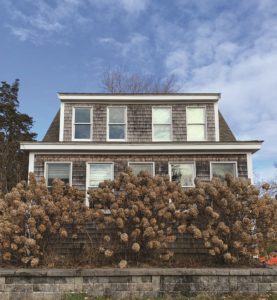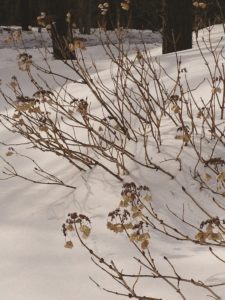There is a stillness that lays itself over our gardens during the winter months. Without the vibrant greens of leaves and pops of color from flowering plants, we are reminded that everything needs rest and time before it can bloom again.
While the gardens, lawns, and trees sleep through January, the contours of our landscape take center stage, punctuated by what Provincetown landscaper Eugene Zhukau calls “winter interest.”

Tassels, pods, dried blossoms, stems — some trimmed into neat, contained shapes, others extending more wildly towards the sky — these are the shapes that will catch low winter light or be outlined in snow.
Hydrangeas, although not native to the Cape, are a botanical staple here, where our well-drained soil and warmer winters help them flourish. We all know their peak-summer white, pink, and vibrant blue puffs, the intensity of blue giving away the pH of the soil they’re standing in (lower pH, more acidic soil makes them bluer). But in winter, too, hydrangeas stand out here — in different ways, depending on the variety and on the gardener.
In his more than 20 years of landscaping in Provincetown, Gunter Leirer says he has heard countless opinions on how best to care for hydrangeas through the colder months.
“It depends entirely on the species,” says Leirer. Knowing whether your plant blooms on old wood or new wood determines the ideal time to nip your spent blossoms for maximizing your flowers in the following season. Those that flower on old wood should be taken soon after flowers fade. Those on new wood are best pruned before new growth begins.
Leirer also prunes to maintain shape for a neat and tidy property over the winter. Since most people want to enjoy the blooms for as long as possible, this kind of selective trimming usually takes place later in the season. “Follow the shape of the plant,” says Leirer, and “stay above the nodes,” which are the beginning buds of new growth.

For all their floriferous beauty, these plants are tough. If you have an old hydrangea that has grown out of control, you can cut a full third of the stems all the way down to the bottom, cutting out the old wood. It may take a few years to get it to the size and shape you want, but the plant can take it.
Some hydrangeas want no attention from pruners at all. Climbing hydrangeas with spent blooms rustling at the ends of their stems can be part of a picturesque winter garden.
Besides being mindful of winter interest, Zhukau says, when you do prune, do it with the holistic well-being of the plant in mind. For example, you never want to cut directly in the middle of the stem, as, often, those stems do not survive the winter.
As for your timing, as long as you’re being selective and cutting correctly, “the best time for pruning,” Zhukau concedes, “is when you’re standing next to the plant and have pruners in hand.”



